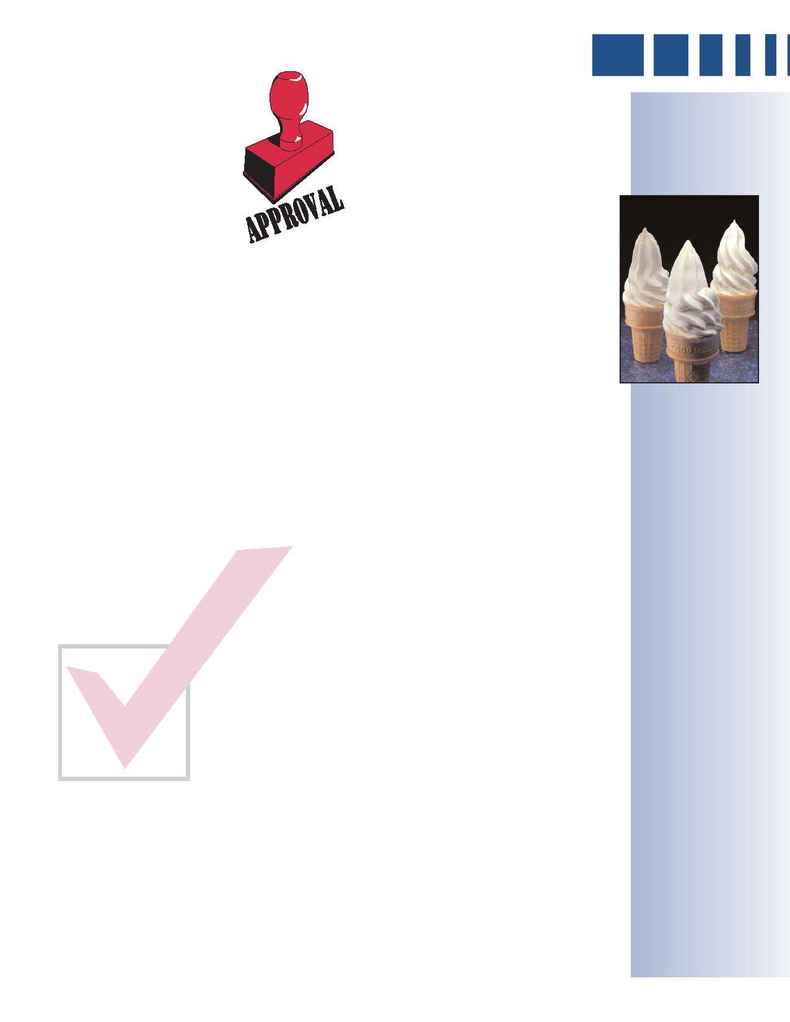
Aspartame Safety Confirmed Again
The safety of aspartame has been con-
firmed by the FDA on 26 separate occa-
sions in the past 23 years alone and by
the Joint Expert Committee on Food
Additives (JECFA) of the World Health
Organization, the Scientific Committee for Food of the European
Community, and regulatory agencies in more than 100 countries.
Most recently, the French Expert Committee on Flavourings, Food
Additives and Processing Aids of the French Food Safety Agency
(AFFSA) reviewed the safety of aspartame again. Following an
extensive two-year review, the AFFSA reaffirmed the safety of aspar-
tame. For more information about aspartame, visit
www.caloriecontrol.org/aspartame.html
Cyclamate Reapproval Pending
The re-approval of cyclamate is still pending in the U.S. Cyclamate
is approved for use in more than 50 countries worldwide. FDA's
Cancer Assessment Committee (CAC) reviewed the scientific evi-
dence and reached the following conclusion in 1984: "The collec-
tive weight of the many experiments... indicates that cyclamate is
not carcinogenic." For more information on cyclamate, visit
www.caloriecontrol.org/cyclamat.html.
Neotame Receives FDA Approval
Neotame, a no-calorie sweetener that is 7,000 to 13,000 times
sweeter than sugar, was recently approved by the FDA. Neotame
(which has a sweet taste like sucrose and unique flavor enhance-
ment properties) can also be blended with other sweeteners. The
FDA approved neotame in July 2002 as a general purpose sweetener
and it can be used in a wide array of products including baked
goods, non-alcoholic beverages (e.g., soft drinks), chewing gum,
confections and frostings, frozen desserts, gelatins and puddings,
jams, jellies, processed fruits and fruit juices, toppings and syrups.
Extensive research has been conducted on neotame to establish its
safety and the FDA approved the sweetener after reviewing more
than 110 studies conducted in animals and humans. Neotame also
is approved for use in Australia and New Zealand. More information
about neotame is available at www.caloriecontrol.org/neotame.html.
Saccharin Warning Label Removed
You may have noticed that saccharin-containing products no
longer carry a "warning label." This is because in December 2000,
former President Clinton signed legislation to remove the warning
label that had been required on saccharin-sweetened foods and
beverages since 1977. After almost a quarter century, the book
finally has been closed on one of America's major food safety
scares of the seventies. Today, following more than a century of safe
use, saccharin remains an important sweetener
in a wide range of sugar-free and low-calorie
products and is approved in over 100 countries.
To learn more about saccharin visit www.calo-
riecontrol.org/sacchar.html.
Sucralose Being Used in More Products
Sucralose, approved by FDA in 1998, is avail-
able in a wide variety of foods, including low-
calorie pancake syrups, diet colas, low-calorie
fruit drinks, low-calorie applesauce, low-calorie
pie fillings, low-calorie ice cream, gelatins,
puddings, sauces, toppings, syrups, chewing
gum, processed fruits, baked goods and confec-
tionery products. Sucralose can also be used as
a tabletop sweetener and is available in a cup
for cup form. Sucralose is now used in hun-
dreds of products within the U.S. For more
information on sucralose, visit
www.caloriecontrol.org/sucralos.html.
Tagatose and Trehalose Designated GRAS
Tagatose has a physical bulk similar to sucrose
and is almost as sweet yet only contributes 1.5
calories per gram. It provides the bulk of sugar
but with less calories and helps to improve the
flavor profile and mouth-feel of products when
combined with low-calorie sweeteners such as
aspartame and Acesulfame K. Tagatose may now
be used in the U.S. food supply, as it has been
determined Generally Recognized As Safe
(GRAS). For more information on tagatose, visit
www.caloriecontrol.org/tagatose.html.
Trehalose is approximately half as sweet as
sugar and therefore is more likely to be used for
cell preservation than for sweetness. Trehalose is
suitable for use in beverages, including fruit
juices, purees and fillings, nutrition bars,
surimi, dehydrated fruits and vegetables and
white chocolate for cookies and chips. Trehalose
has been determined GRAS. For more
information on trehalose, visit
www.caloriecontrol.org/trehalose.html.
Polyols Reduce Calories and Maintain Oral Health
In addition to low-calorie sweeteners, polyols
(also known as sugar replacers) have been used
for many years to replace sugars in a wide variety
of products such as chewing gums, candies, ice
5
(continued on page 7)
The "Low Down" on Low-Calorie Sweeteners
(continued from page 4)
